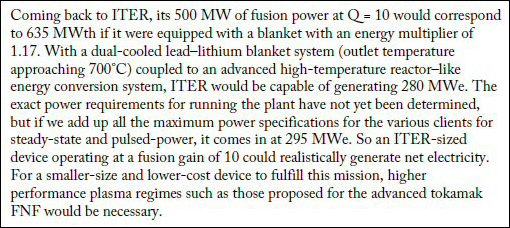Sept. 30, 2020
Leo Rafael Reif
President, Massachusetts Institute of Technology
Dear President Reif,
In a consistent, multi-year, public-relations campaign, Dennis G. Whyte, the director of the MIT Plasma Science and Fusion Center, and Martin Greenwald, the deputy director of the center, have communicated with members of the news media and created the false impression that their next reactor design, known as SPARC, is designed to produce power at a rate two-to-ten times as much as the reactor will require to operate.
The root of the deception is founded on the intersection of two conflicting themes. On the one hand, for 70 years, fusion scientists have promised the public a fusion reactor that produces more energy than it consumes. Most news articles that discuss fusion remind us that this is the penultimate goal, short of producing electricity. But no electricity from fusion will ever be produced unless the net power gain of an overall reactor is positive rather than negative. The second of the intersecting themes is that, for 70 years, fusion scientists have known that no fusion reactor — including the planned SPARC and ITER reactors — has been designed to produce power at a rate greater than it will consume.
Fusion representatives, for decades, have leveraged this foundational disparity and structured the language in their claims to feed the public’s expectation of a fusion reactor that will produce a net positive power rate, despite the fact that the representatives knew that no such reactor is imminent. Fusion representatives create the illusion with two well-established tactics. The tactics apply to the forthcoming SPARC and ITER reactors and perhaps other planned fusion reactors.
The first tactic is that, without clearly explaining to the public and news media, they offer input power values that are not associated with the overall reactors. Instead, they provide input values that are associated only with the rate of thermal power that enters the reaction chambers to heat the fuel.
The second tactic is that the fusion representatives never disclose the rate of input electrical power that these fusion reactors will require to operate. If a journalist is savvy enough to realize what the scientists are doing, and the journalist asks the fusion representatives for the rate of required electrical input power for the reactors, the representatives then say that the question is irrelevant because present fusion reactors are not designed for overall net power rates. This is circular reasoning.
Here’s a brief summary of the recent activities of the directors in the MIT fusion center.
March 9, 2018, Press Release
The first press release that MIT issued about SPARC said this:
SPARC is designed to produce about 100 MW of heat. While it will not turn that heat into electricity, it will produce, in pulses of about 10 seconds, as much power as is used by a small city. That output would be more than twice the power used to heat the plasma, achieving the ultimate technical milestone: positive net energy from fusion.
Your scientists created the illusion that SPARC’s projected output would be sufficient for a small city. They created the illusion that SPARC would produce an output of 100 megawatts of heat that — if the reactor was so designed — could be turned into electricity. This is dishonest; it is an example of a bait-and-switch technique. People who are experts in fusion will recognize the nuanced language. The MIT fusion scientists were not talking about net power from a fusion reactor. Instead, they were talking about net power from a fusion reaction.
Net energy from a fusion reactor means you have some amount of power left over, after subtracting the input power used to operate the reactor. Net power from a fusion reaction refers only to the pure physics; it does not account for or subtract the input power required to operate the reactor.
Thus, for example, MIT scientists misled Jeff Tollefson, a journalist with Nature, to write that SPARC is “a prototype reactor that can generate more energy than it consumes.”
No Reactor Net Power
Because the plans for SPARC specify that the rate of thermal power injected into the fuel will be 25 to 30 megawatts, this means that the rate of electrical power required to produce the injected thermal power will be at least 75 to 90 megawatts. That leaves the question of the rate of electrical power required to operate the machine. I asked Greenwald for that value last year. He didn’t respond to my e-mails or phone messages.
Unless the SPARC reactor design requires an extraordinarily low rate of input electrical power, there will not be a sufficiently high net output power rate to, hypothetically, power a single light bulb, let alone a small city. But again, this is the point at which fusion representatives use circular reasoning to claim they are unfairly judged; they insist that their experiments are not designed for net reactor power output.
June 27, 2019, Press Release
In a June 27, 2019, press release, Commonwealth Fusion Systems, the private spin-off associated with MIT, said that SPARC will “demonstrate net energy gain from fusion for the first time in history.” This claim played into the public’s expectation and long-awaited hope of net energy gain from a fusion reactor. Yet, by its ambiguity, the claim provided a deceptive but thin veil of scientific accuracy that could be defended as net energy gain from a fusion reaction.
Aug. 5, 2019, Physics World Article
On Aug. 5, 2019, an MIT student and a visiting scientist writing in Physics World claimed that SPARC would be a new “fusion device aiming to be the first to achieve net energy gain.” That phrase, if read by itself, is unequivocally false because the device is not designed to achieve net energy gain. Knowing this, the authors tried to provide cover by immediately following that claim with a definition of net energy gain for a fusion reaction, not a fusion device. In other words, they made a false claim, then tried to defend it with a definition that was inconsistent with device net energy gain.
Sept. 29, 2020, Press Release
The Sept. 29, 2020, press release continued propagating the half-truth about MIT’s fusion research. The MIT scientists said that, according to the design, SPARC will produce twice as much fusion energy “as the amount of energy pumped in to generate the reaction.” Then they said it might even produce ten times as much.
It was the same deception; the MIT fusion scientists were only referring to the pure physics, the power going into and coming out of the reaction. They were not comparing the power going into and coming out of the reactor. By telling this half-truth to members of the news media who are not expected to be fusion experts, they manipulated the news media to unknowingly exaggerate what SPARC is designed to do.
Thus, MIT scientists misled, for example, Henry Fountain, a journalist with the New York Times, to write that SPARC, if successful, will “produce as much as 10 times the energy it consumes.”
Research Integrity
Journalists are not to blame for failing to discern the technical nuances of nuclear fusion experts. Scientists are responsible for communicating clearly and transparently, particularly when making claims in press releases. Your fusion scientists repeatedly breached their duty to communicate their research accurately and transparently. They saw the advantageous results from their first press release and did it again, and again.
This leaves the question about how your university teaches its students about research integrity and whether your university condones this type of behavior.
I welcome your response.
Steven B. Krivit
New Energy Times
DISTRIBUTION
Leo Rafael Reif, President, Massachusetts Institute of Technology
Maria T. Zuber, Office of the Vice-President for Research, Massachusetts Institute of Technology
Sarah McDonnell, Media Contact, Massachusetts Institute of Technology
Martin Greenwald, Deputy Director, Massachusetts Institute of Technology Plasma Science and Fusion Center
Dennis G. Whyte, Director, Massachusetts Institute of Technology Plasma Science and Fusion Center
Jeff Tollefson, Nature
Henry Fountain, New York Times
RELATED:
Did MIT and Commonwealth Fusion Systems Mislead Fusion Investors?
50. Omitting the ITER Input Power – Martin Greenwald’s Role






